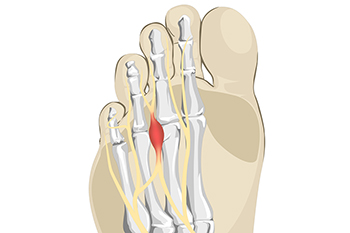Items filtered by date: June 2024
Effective Stretches and Exercises for Plantar Fasciitis Relief

Plantar fasciitis, a common cause of heel pain, can be alleviated through specific stretches and exercises designed to strengthen and relax the plantar fascia. One effective stretch is the calf stretch, performed by leaning against a wall with one leg extended back and the other bent forward, ensuring both heels are on the ground. This stretch targets the calf muscles and Achilles tendon, providing relief. The towel stretch involves sitting with legs extended, looping a towel around the toes, and gently pulling them towards the body to stretch the bottom of the foot. Rolling a tennis ball or a frozen water bottle under the foot can massage the plantar fascia and reduce tension. Additionally, toe curls and picking up marbles with the toes can strengthen the muscles in the foot. If you have heel pain, it is suggested that you visit a podiatrist who can accurately diagnose plantar fasciitis, and stress how specific stretches may help to provide relief.
Plantar fasciitis can be very painful and inconvenient. If you are experiencing heel pain or symptoms of plantar fasciitis, contact one of our podiatrists from Toe-tal Family Footcare Associates. Our doctors can provide the care you need to keep you pain-free and on your feet.
What Is Plantar Fasciitis?
Plantar fasciitis is the inflammation of the thick band of tissue that runs along the bottom of your foot, known as the plantar fascia, and causes mild to severe heel pain.
What Causes Plantar Fasciitis?
- Excessive running
- Non-supportive shoes
- Overpronation
- Repeated stretching and tearing of the plantar fascia
How Can It Be Treated?
- Conservative measures – anti-inflammatories, ice packs, stretching exercises, physical therapy, orthotic devices
- Shockwave therapy – sound waves are sent to the affected area to facilitate healing and are usually used for chronic cases of plantar fasciitis
- Surgery – usually only used as a last resort when all else fails. The plantar fascia can be surgically detached from the heel
While very treatable, plantar fasciitis is definitely not something that should be ignored. Especially in severe cases, speaking to your doctor right away is highly recommended to avoid complications and severe heel pain. Your podiatrist can work with you to provide the appropriate treatment options tailored to your condition.
If you have any questions please feel free to contact our office located in Vista, CA and Las Vegas, NV . We offer the newest diagnostic and treatment technologies for all your foot and ankle needs.
Causes of Chronic Foot Pain

Chronic foot pain is more than just a nuisance, It can significantly impact your daily life and mobility. Trauma, whether from a sudden injury or repetitive strain, can lead to a variety of foot issues including sprains, strains, and stress fractures. Overuse injuries, common among athletes and those with physically demanding jobs, can result in conditions like Achilles tendonitis and plantar fasciitis. Biomechanical factors, such as improper footwear or structural misalignment, can also contribute to chronic foot pain by causing conditions like bunions, corns, and neuromas. Underlying medical conditions, such as diabetes, gout, and peripheral neuropathy, can result in foot pain and increase the risk of complications. Additionally, infections like athlete's foot or ingrown toenails can cause persistent discomfort if not properly treated. If chronic foot pain is limiting your mobility and interfering with daily activities, it is suggested that you make an appointment with a podiatrist for an exam and treatment.
Foot Pain
Foot pain can be extremely painful and debilitating. If you have a foot pain, consult with one of our podiatrists from Toe-tal Family Footcare Associates. Our doctors will assess your condition and provide you with quality foot and ankle treatment.
Causes
Foot pain is a very broad condition that could be caused by one or more ailments. The most common include:
- Bunions
- Hammertoes
- Plantar Fasciitis
- Bone Spurs
- Corns
- Tarsal Tunnel Syndrome
- Ingrown Toenails
- Arthritis (such as Gout, Rheumatoid, and Osteoarthritis)
- Flat Feet
- Injury (from stress fractures, broken toe, foot, ankle, Achilles tendon ruptures, and sprains)
- And more
Diagnosis
To figure out the cause of foot pain, podiatrists utilize several different methods. This can range from simple visual inspections and sensation tests to X-rays and MRI scans. Prior medical history, family medical history, and any recent physical traumatic events will all be taken into consideration for a proper diagnosis.
Treatment
Treatment depends upon the cause of the foot pain. Whether it is resting, staying off the foot, or having surgery; podiatrists have a number of treatment options available for foot pain.
If you have any questions, please feel free to contact our office located in Vista, CA and Las Vegas, NV . We offer the newest diagnostic and treatment technologies for all your foot care needs.
Pressure Injuries and Diabetic Foot Wounds
 Pressure injuries and diabetic foot wounds are two distinct yet potentially serious conditions that affect the feet, often requiring specialized medical attention from a podiatrist. Pressure injuries, commonly known as bed sores or ulcers, develop due to prolonged pressure on specific areas of the body, typically seen in individuals who are immobile or bedridden. They often occur on bony prominences, such as the heels, ankles, or toes, and lead to tissue damage and open wounds. Diabetic foot wounds are a consequence of diabetes-related complications, including peripheral neuropathy and impaired circulation. These wounds typically appear as ulcers, blisters, or cuts and are slow to heal due to poor blood flow and reduced sensation in the feet. Diagnosing these conditions involves careful examination, often including assessment of wound size, depth, and surrounding tissue condition. Prompt intervention is imperative to prevent complications like infection or tissue necrosis. If you have a foot wound or ulcer, it is strongly suggested that you seek immediate evaluation and treatment from a podiatrist to prevent further complications and promote healing.
Pressure injuries and diabetic foot wounds are two distinct yet potentially serious conditions that affect the feet, often requiring specialized medical attention from a podiatrist. Pressure injuries, commonly known as bed sores or ulcers, develop due to prolonged pressure on specific areas of the body, typically seen in individuals who are immobile or bedridden. They often occur on bony prominences, such as the heels, ankles, or toes, and lead to tissue damage and open wounds. Diabetic foot wounds are a consequence of diabetes-related complications, including peripheral neuropathy and impaired circulation. These wounds typically appear as ulcers, blisters, or cuts and are slow to heal due to poor blood flow and reduced sensation in the feet. Diagnosing these conditions involves careful examination, often including assessment of wound size, depth, and surrounding tissue condition. Prompt intervention is imperative to prevent complications like infection or tissue necrosis. If you have a foot wound or ulcer, it is strongly suggested that you seek immediate evaluation and treatment from a podiatrist to prevent further complications and promote healing.
Wound care is an important part in dealing with diabetes. If you have diabetes and a foot wound or would like more information about wound care for diabetics, consult with one of our podiatrists from Toe-tal Family Footcare Associates. Our doctors will assess your condition and provide you with quality foot and ankle treatment.
What Is Wound Care?
Wound care is the practice of taking proper care of a wound. This can range from the smallest to the largest of wounds. While everyone can benefit from proper wound care, it is much more important for diabetics. Diabetics often suffer from poor blood circulation which causes wounds to heal much slower than they would in a non-diabetic.
What Is the Importance of Wound Care?
While it may not seem apparent with small ulcers on the foot, for diabetics, any size ulcer can become infected. Diabetics often also suffer from neuropathy, or nerve loss. This means they might not even feel when they have an ulcer on their foot. If the wound becomes severely infected, amputation may be necessary. Therefore, it is of the upmost importance to properly care for any and all foot wounds.
How to Care for Wounds
The best way to care for foot wounds is to prevent them. For diabetics, this means daily inspections of the feet for any signs of abnormalities or ulcers. It is also recommended to see a podiatrist several times a year for a foot inspection. If you do have an ulcer, run the wound under water to clear dirt from the wound; then apply antibiotic ointment to the wound and cover with a bandage. Bandages should be changed daily and keeping pressure off the wound is smart. It is advised to see a podiatrist, who can keep an eye on it.
If you have any questions, please feel free to contact our office located in Vista, CA and Las Vegas, NV . We offer the newest diagnostic and treatment technologies for all your foot care needs.
Demystifying Morton's Neuroma

Morton's neuroma, named after the American surgeon Thomas G. Morton who first described it in the 19th century, is a painful condition affecting the nerves in the foot. This benign growth typically forms between the third and fourth toes, resulting from compression or irritation of the interdigital nerve. The exact cause of Morton's neuroma remains elusive, but factors such as wearing tight or high-heeled shoes, engaging in repetitive high-impact activities, or foot deformities may contribute to its development. Symptoms of Morton's neuroma often include a sharp, burning pain or sensation of a lump or foreign object in the ball of the foot. Individuals may also experience numbness, tingling, or a feeling of walking on a pebble. As the condition progresses, discomfort may worsen and become more persistent, particularly during weight-bearing activities. If you have pain in this part of your foot, it may be Morton's neuroma, and it is suggested that you visit a podiatrist. This type of doctor can accurately diagnose and effectively treat this condition.
Morton’s neuroma is a very uncomfortable condition to live with. If you think you have Morton’s neuroma, contact one of our podiatrists of Toe-tal Family Footcare Associates. Our doctors will attend to all of your foot care needs and answer any of your related questions.
Morton’s Neuroma
Morton's neuroma is a painful foot condition that commonly affects the areas between the second and third or third and fourth toe, although other areas of the foot are also susceptible. Morton’s neuroma is caused by an inflamed nerve in the foot that is being squeezed and aggravated by surrounding bones.
What Increases the Chances of Having Morton’s Neuroma?
- Ill-fitting high heels or shoes that add pressure to the toe or foot
- Jogging, running or any sport that involves constant impact to the foot
- Flat feet, bunions, and any other foot deformities
Morton’s neuroma is a very treatable condition. Orthotics and shoe inserts can often be used to alleviate the pain on the forefront of the feet. In more severe cases, corticosteroids can also be prescribed. In order to figure out the best treatment for your neuroma, it’s recommended to seek the care of a podiatrist who can diagnose your condition and provide different treatment options.
If you have any questions, please feel free to contact our office located in Vista, CA and Las Vegas, NV . We offer the newest diagnostic and treatment technologies for all your foot care needs.